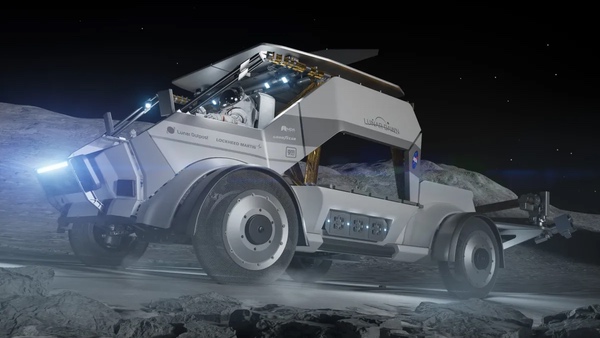Lunar rover racingby Jeff Foust
|
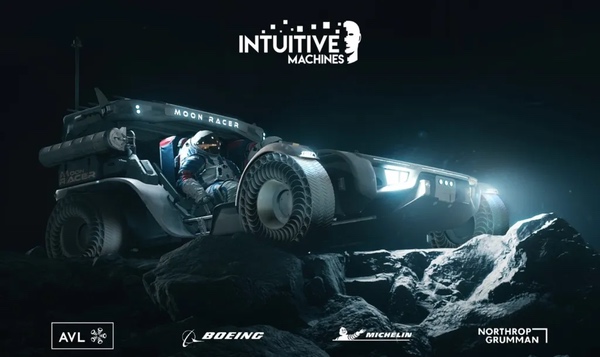 Intuitive Machines is leading the Moon RACER team also selected for the LTV program. (credit: Intuitive Machines) |
Rovers as a service
On April 3, NASA announced the winners of the long-awaited Lunar Terrain Vehicle (LTV) services contract. NASA started planning for the LTV more than four years ago with a series of requests for information on how to procure a small, unpressurized lunar rover. NASA finally issued a request for proposals last May for the LTV competition, with nine companies ultimately bidding on the competition.
| “Think of a hybrid of the Apollo-style lunar rover that was driven by our astronauts and an uncrewed mobile science platform,” said Wyche. |
At a briefing at the Johnson Space Center, NASA said it selected teams led by Intuitive Machines, Lunar Outpost, and Venturi Astrolab for the LTV program. All three would get initial task orders for one-year feasibility studies leading to preliminary design reviews. NASA did not disclose the value of the task orders but Intuitive Machines said their order was worth $30 million; presumably the other two companies received similarly sized orders.
The LTV is intended primarily to be driven by NASA astronauts during Artemis missions, but can also be teleoperated when astronauts are not present for science or other applications, either for NASA or other customers. “Think of a hybrid of the Apollo-style lunar rover that was driven by our astronauts and an uncrewed mobile science platform,” explained Vanessa Wyche, director of JSC, at the briefing.
NASA officials at the briefing declined to go into details about the selection of the three companies, or even say how many proposals it received, claiming that they were still in a procurement “blackout” phase. That included no details about the potential value of the contracts each winning company received.
NASA released last week the source selection statement for the LTV competition. It confirmed that nine companies submitted proposals and that three—from automotive technology company 3Sixty Degrees, space robotics company GITAI, and a company identified only as ORBIT—were deficient and not evaluated.
NASA evaluated the remaining six proposals and concluded that three did not make the cut, but didn’t explain why. Those proposals came from Astrobotic, Blue Origin, and Leidos; the first two had not publicly announced plans to compete for an LTV contract but Leidos had announced its plans a year ago unveiling a rover design and a team that included, among others, NASCAR.
At that briefing, the companies were circumspect about their rover designs, providing few technical details like range, speed, payload capacity, and the like. Intuitive Machines, for example, is leading a team for concept called Moon Reusable Autonomous Crewed Exploration Rover, or Moon RACER. That team includes aerospace companies Boeing and Northrop Grumman as well as automotive companies AVL and Michelin.
Steve Altemus, CEO of Intuitive Machines, said at that briefing the company would be refining the Moon RACER design over the next year. “There are a number of the subsystems that we have put in as the initial design that will be traded,” he said, from power to suspension.
The NASA source selection statement praised the Intuitive Machines design for including “a unique type of detachable trailer architecture” but warned that, when attached, it would prevent the rover’s robotic arm from collecting samples. The design had the lowest price for development and operations of the three, at just under $1.7 billion, but also the lowest “mission suitability” score—a metric that assesses technical and management factors—of 705 out of 1,000.
| “I want a set of those [Goodyear lunar rover] tires for my own offroad vehicle,” said Cyrus. |
Lunar Outpost’s Lunar Dawn rover also has a joint aerospace/automotive roster of teammates such as Lockheed Martin, MDA Space, General Motors, and Goodyear. Lunar Outpost itself is by far the smallest of those companies, a startup working on smaller robotic rovers before winning an LTV contract.
NASA, in its assessment, gave Lunar Dawn a higher score at 863 but noted it had a higher price, at nearly $1.73 billion. It noted it featured “an advanced technology for energy storage that is a reasonable and feasible approach to greatly exceed the vehicle performance requirements while meeting battery safety requirements,” an apparent reference to GM’s electric-vehicle battery technology being incorporated into the design.
Lunar Outpost CEO Justin Cyrus also highlighted the tires of the rover, being developed by Goodyear, suggesting there were terrestrial spinoffs possible. “I’m really excited to see how they can bring some of the technology that we’re using as part of LTVS back down here to Earth,” he said at the briefing. “I want a set of those tires for my own offroad vehicle.”
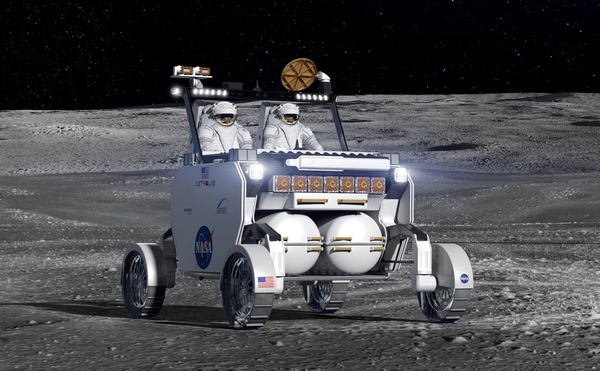 Astrolab is developing its FLEX rover for the LTV program. (credit: Astrolab) |
Both Lunar Dawn and Moon RACER look like one might expect from a slightly futuristic rover design; the illustrations they released looked like something you might expect to see on a sci-fi novel cover, if in some cases oddly streamlined for travel on an airless world. Astrolab’s Flexible Logistics and Exploration (FLEX) rover, though, is different: a boxy design with astronauts standing at the back, it looks less like a lunar rover than a lunar Zamboni.
NASA, though, was clearly impressed with the design, giving it the highest mission suitability score of the three at 905. (It also had the highest price, at nearly $1.93 billion.) The source selection statement cited “multiple exceedances of required minimum requirements” in the design, like its ability to climb higher slopes. Astrolab also proposed an option to deliver the rover as a co-manifested payload on the SpaceX Starship lander for Artemis 4, whereas NASA required companies only to have the rover ready by the time Artemis 5 landed.
“We’re coming into this with a lot of experience already with the technologies we’re planning to apply here,” Jaret Matthews, CEO of Astrolab, said at the briefing, noting the company has racked up thousands of hours on a terrestrial prototype of FLEX and planned to launch a robotic version on a commercial Starship mission as soon as 2026. “We intend to exceed NASA’s requirements.”
NASA, though, appeared to raise questions about Astrolab’s ability to follow through: its assessment of the startup’s limited past performance in the source selection statement gave it “a Low level of confidence that the Offeror will successfully perform the required effort.” Astrolab does not have any aerospace or automotive heavyweights on its team, working instead with companies like Axiom Space, which has a separate NASA contract to develop Artemis spacesuits.
Nonetheless, Wyche noted in the source selection statement that all three companies had satisfied the minimum past performance requirements, which “gives me confidence that the teams are capable and possess the necessary experience to perform the work under the LTVS contract.”
Like many other commercial initiatives, from cargo and crew transportation for the International Space Station to lunar landers, NASA is procuring a service, allowing the companies to offer the rovers to other customers, particularly when NASA is not using them on Artemis missions that, initially, will be annual expeditions spending a week on the surface.
| “We believe in the early phase that NASA will have to be somewhat of an anchor tenant,” Kearney said, with more commercial users coming later. |
That approach was intended to offer companies flexibility on how they achieved the technical requirements of the program. Lara Kearney, manager of NASA’s Extravehicular Activity and Human Surface Mobility program, noted that it was up to the companies to determine how they would provide ten years of rover services under the contract: one rover lasting the full ten years or a new rover every year for ten years. (None of the companies took either extreme: the source selection statement said that all three companies anticipated delivering one replacement rover over that ten-year period.)
How that service model will work in terms of attracting other customers remains to be seen. At the briefing, Kearney said NASA expected initially to be the biggest customer, using the rover for up to 75% of the time. That fraction would decrease over the ten-year contract, she predicted, as more customers emerge.
“We believe in the early phase that NASA will have to be somewhat of an anchor tenant,” she said. “We hope that, over the ten-year operating life of this vehicle, we can start bringing in more and more commercial requests as the market evolves.”
The emphasis is on vehicle, singular: NASA, at the end of the year-long feasibility studies, plans to award a task order for development and demonstration of the rover to a single company. That is a break from past practices for services contracts where NASA has picked two or more companies. When NASA, three years ago, selected only SpaceX for its Human Landing System (HLS) program, the criticism, from industry and Congress, was strong enough that NASA went back and held a competition for a second lander.
Kearney defended NASA’s approach at the briefing, saying it is “based on available budgets” but suggested there was room to modify it in the future. “We have a contract mechanism that will allow companies to continue to compete for future demonstrations and service periods,” she said.
“Some of it comes down to just budgets. We have constrained budgets at the agency that we have to live within,” said Chris Hansen, deputy manager of the program, during another briefing last week at the 39th Space Symposium in Colorado Springs. “We maintain competition as far as we can into that.”
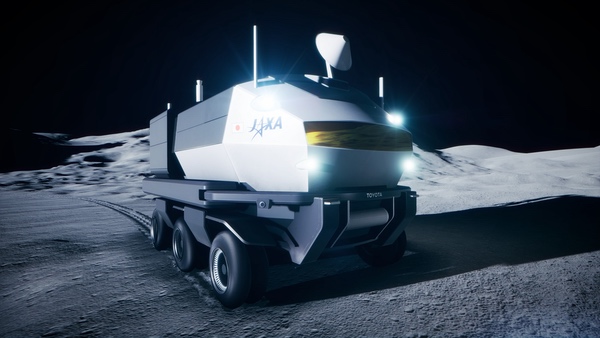 Toyota is working with the Japanese space agency JAXA on the Lunar Cruiser pressurized rover. (credit: Toyota) |
Lunar cruising
At the April 3 briefing, one reporter asked how the LTV would fit into NASA’s plans given reports that Japan was developing a larger pressurized rover. Agency officials said that the proposed rover would offer a greater range than the LTV, but did not go into details, citing an announcement planned for the next week.
That announcement came exactly a week later, when NASA and the Japanese government announced they had signed an agreement about additional cooperation on Artemis beyond Japanese contributions to the lunar Gateway. Under that agreement, the Japanese space agency JAXA would provide NASA a large pressurized rover in time for the Artemis 7 mission in the early 2030s.
JAXA has been working with Toyota for several years on a rover concept they called “Lunar Cruiser.” The rover, powered by fuel cells, would support two astronauts for up to 30 days for extended journeys beyond the landing site; it would, in essence, be a mobile habitat, lasting for ten years.
NASA, in turn, would deliver Lunar Cruiser to the surface of the Moon, using cargo versions of the HLS landers that SpaceX and Blue Origin are building. NASA would also provide two seats for Japanese astronauts on future Artemis lunar landing missions. While NASA has previously allocated seats on Gateway missions to JAXA as well as ESA, the Canadian Space Agency, and the United Arab Emirates, Japan is in line to be the first nation after the United States to land astronauts on the Moon as part of Artemis.
Neither NASA nor JAXA, though, would say exactly when those Japanese astronauts would get to walk on the Moon. Asked about that at a briefing April 10, NASA administrator Bill Nelson offered a succinct response: “It depends.”
| “We’re all-in on this. It’s our main focus,” Matthews said of Astrolab. |
The implementing agreement that the two countries signed last week offered a range of criteria for crew assignments: “The timing of the flight opportunities will be determined by NASA in line with existing flight manifesting and crew assignment processes and will take into account program progress and constraints, MEXT’s [Japan’s Ministry of Education, Culture, Sports, Science and Technology] request for the earliest possible assignment of the Japanese astronauts to lunar surface missions, and major PR [pressurized rover] milestones such as when the PR is first deployed on the lunar surface.”
NASA associate administrator Jim Free said at the Space Symposium briefing a day after the announcement that it was premature to be thinking about what missions the Japanese astronauts would be assigned to, with no crews from any agency select for Artemis 3 and beyond. “Were a ways from assigning those folks today.”
It’s likely, though, that at least one of the Japanese astronauts will fly before the rover itself. In December, Vice President Kamala Harris said at a National Space Council meeting that it was the goal of the US “to land an international astronaut on the surface of the Moon by the end of the decade.”
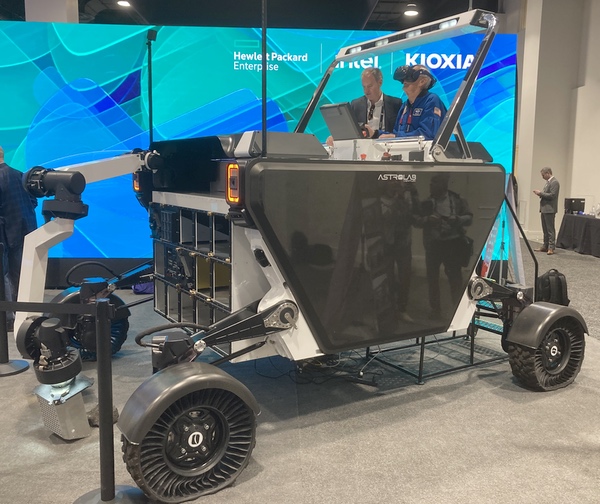 Apollo 16 astronaut Charlie Duke, wearing a VR headset, “drives” Astrolab’s lunar rover on display at a booth during the 39th Space Symposium last week. (credit: J. Foust) |
In the sprawling exhibit hall at Space Symposium, JAXA had a small scale model of Lunar Cruiser on display. At another booth, though, Astrolab had brought their full-sized terrestrial prototype of their FLEX rover. While stationary, visitors could climb aboard, don a VR headset, and “drive” the rover across the terrain of the lunar south polar region.
“We’re all-in on this. It’s our main focus,” Matthews said of Astrolab at the booth. He noted the LTV version of FLEX will be slightly different from the one on display, he said slightly stretched out with larger tires, but otherwise the same core platform.
“To have the validation of NASA is huge, to have the opportunity to work alongside them is huge,” he said of winning the LTV award.
While he was talking, though, a different kind of validation took shape. An unexpected but very welcome visitor showed up at the booth: Charlie Duke, the Apollo 16 astronaut. Within moments, he was on FLEX, wearing the headset and driving across the Moon, 52 years after traveling around the Descartes Highlands on the Apollo lunar rover. The torch—or, perhaps, the keys to the rover—had been passed.
Note: we are now moderating comments. There will be a delay in posting comments and no guarantee that all submitted comments will be posted.
